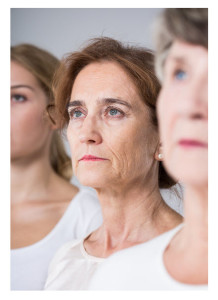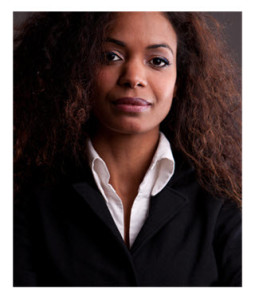Interrupted. Talked over. Silenced. “Subtle sexism” includes behaviors so routine in a woman’s life that we may come to accept them, forgetting how prevalent and damaging they are.
 Among the most common offenders: dismissal of our opinions (scoffing, eye rolling, ignoring); others taking credit for our ideas; assumptions about qualities of leadership; commentary on our voices, our faces (“pretty enough”), our bodies (too fat, too flat, too sexy, not sexy enough), our wardrobes, our hair…
Among the most common offenders: dismissal of our opinions (scoffing, eye rolling, ignoring); others taking credit for our ideas; assumptions about qualities of leadership; commentary on our voices, our faces (“pretty enough”), our bodies (too fat, too flat, too sexy, not sexy enough), our wardrobes, our hair…
Isn’t subtle sexism a factor in women internalizing professional rejection more than men?
And then there are those pesky double standards that some might consider anything but subtle.
Sexism, Ageism, Looksism. And of Course, Racism.
Is this something I have experienced in my life? Definitely. Something you have experienced as well? I’m guessing that’s a yes. Something I have managed to work around, and you have, too?
No doubt, to an extent. That “extent” is governed by how many of those “isms” you’re battling, and the circumstances in which you’re keeping up the brave (and necessary) fight.
So what do we do?
Raise these issues, publicly and privately, and keep raising them. They impact our safety, our quality of life, our livelihoods, our communities. And when it comes to sexism, beyond the cumulative effects of being diminished or dismissed, it’s also tiring, time-consuming, and momentum-killing.
Here is where I find myself today: I face subtle sexism less now than a few years back. This is by virtue of my professional setting — I no longer work in a traditional corporate environment — and also, my age.
The age thing?
 It’s a double-edged sword, certainly; invisibility and ageist assumptions are challenges in their own right. Suffice it to say that the competence, confidence, and focus we acquire with the years helps beat back the gender bias — when we persist and insist… unapologetically.
It’s a double-edged sword, certainly; invisibility and ageist assumptions are challenges in their own right. Suffice it to say that the competence, confidence, and focus we acquire with the years helps beat back the gender bias — when we persist and insist… unapologetically.
Like most women, I learned to deal with mansplaining and manterruptions, especially in professional contexts. One of the survival skills I have acquired as I have matured — interrupting the interrupter, though I loathe having to do it. Another necessity? Steeling myself against disapproving, appearance-based remarks — “looksism” — as criteria for evaluation of a person’s character or qualifications. But let’s not forget what salary data tell us. Good looks do pay.
In light of tumultous news on the world and domestic stage, virtually daily these past few months, it’s easy and understandable to lose sight of issues like ongoing, systemic bias. That doesn’t mean that we should. Allow me to direct your attention to a few editorial pieces from last fall as follows.
This New York Times column offers insight on “manterruptions” in the context of the 2016 presidential debates.
This coverage of subtle sexism, originally appearing in Alternet, notes higher standards and double standards at the top of the list of persistent barriers, an issue that most working women would recognize.
Nothing “Subtle” About It
Whatever your opinion on the election and its outcome, I do think the reminder that subtle sexism is pervasive — and “subtle” may be a misleading term — is something that all of us ought to think about. 51% of us are female. And if you’re part of the remaining 49%, you have mothers, daughters, sisters, spouses, friends, colleagues, and others you admire… presumably, you don’t wish to offend them, much less systematically silence them.
Bustle offers a nice summary of types of subtle sexism, and not solely in the workplace. These include judgment regarding marital status, and subsequent expectations in terms of marital responsibilities (in particular, parenting). These are subjects that come up frequently in the media, and topics I’ve discussed here as well.
On the division of labor in domestic life, notions of egalitarian marriage remain one thing in theory, even with the best of intentions between two partners who are both working, but pose problems when we’re in the “thick of it” — trying to be good partners, good parents, good workers, and responsible members of society.
About the concerns women have with speaking up, knowing their mistakes will be taken as more glaring than a male colleague’s, we edge our way into the arena of “implicit bias.” This is a term that was raised during the debates last year, and unfortunately, left to wither away in the wake of noisier conversation. Cue the commentary on who “looks” presidential…
 In case you don’t recall, the issue of implicit bias was raised by Hillary Clinton in response to a question on race relations and criminal justice. Research has long told us that what we notice first in others is gender and race. Implicit bias that includes both is not a fact or state of affairs that applies purely to a group, but rather, is an unconscious human response, that nonetheless can be managed by education, conscious choice, and experience.
In case you don’t recall, the issue of implicit bias was raised by Hillary Clinton in response to a question on race relations and criminal justice. Research has long told us that what we notice first in others is gender and race. Implicit bias that includes both is not a fact or state of affairs that applies purely to a group, but rather, is an unconscious human response, that nonetheless can be managed by education, conscious choice, and experience.
I recall an excellent point on a broadcast last year in which one of the panelists, a woman, pointed out that implicit bias is only dangerous when the one whose bias is activated is in a position of power to do harm.
Think about that.
Physical harm, with a weapon. Psychological harm, through fear-inducing actions. Economic harm, through denial of opportunities. Harm that could be reduced, theoretically, through awareness and changing experience — and not pretending that bias doesn’t exist.
Is Bias Inevitable?
We are born into our skins and our bodies and the physicality of each, positively and negatively reinforced by experience. Over time, the resulting recipe is absorbed into who we are — what we dare, how we feel about ourselves, what frightens us, what makes us confident, optimistic, hopeful… or suspicious, wary, contemptuous.
Yes, it’s true enough that those with money (especially) can do a great deal to change body shape or hair color or features, and even sex. But skin color? No. Gender, for the majority of us? No. Height? All platform shoes, heels, and lifts aside… certainly not.
Yet we continue to perceive taller people as better leaders; we pay them more. We perceive thinner people as superior at their jobs (more disciplined, more competent); we pay them more. We perceive attractive women — attractive according to very particular norms — as superior at their jobs; we pay them more. And yes, if you’re a man, gender pay gap data reflects that we pay you more.
 Must we still shout to be heard? Must we still conform to someone else’s idea of beauty to be treated as having a legitimate voice? Must we be of a certain gender or age or height or girth — not to mention hue of skin — to be afforded basic respect?
Must we still shout to be heard? Must we still conform to someone else’s idea of beauty to be treated as having a legitimate voice? Must we be of a certain gender or age or height or girth — not to mention hue of skin — to be afforded basic respect?
Aren’t we adult enough to do better?
I fear I know the answer to that. I would love to be wrong.
You May Also Enjoy
Have you seen the movie, “Hidden Figures” yet? If not, I strongly recommend it. We rented it from Amazon the other night, and I have been thinking about our country’s inherent system of racism and sexism ever since. While I never had the kind of looks that got noticed (kind of a blessing, actually) I certainly experienced blatant sexism in the workplace — especially when I was in a corporate setting. Yes, Donald Trump and his crew are very familiar archetypes to me and I certainly didn’t stand up to them the way I would now.
Judith, Thanks for this comment. I’ve been wanting to see Hidden Figures, but haven’t yet. Now I’m moving it up on my “to rent” list.
You raise an interesting point about the “looks” factor. I remember a very beautiful, statuesque, and extremely smart friend who had to walk a fine line. Her beauty was an asset in some ways, and a problem in others. Assumptions about why she was where she was were made, discounting the sheer intellect and competence that made her successful. I’ve always felt there can be advantages to a certain ability to blend in — the realm of “attractive enough” so as not to be a problem, but not so much as to distract.
We watched and discussed “Hidden Figures” this weekend – a new favorite movie!